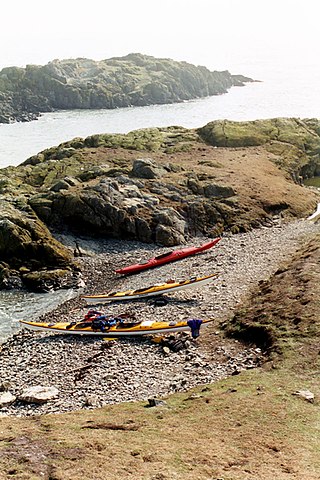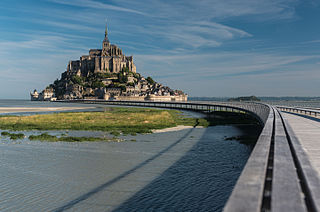
Manche is a coastal French département in Normandy on the English Channel, which is known as La Manche, literally "the sleeve", in French. It had a population of 495,045 in 2019.

Wimborne Minster is a market town in Dorset in South West England, and the name of the Church of England church in that town. It lies at the confluence of the River Stour and the River Allen, 5 miles (8 km) north of Poole, on the Dorset Heaths, and is part of the South East Dorset conurbation. According to Office for National Statistics data the population of the Wimborne Minster built-up area as of 2014 was 15,552.

Brownsea Island is the largest of the islands in Poole Harbour in the county of Dorset, England. The island is owned by the National Trust with the northern half managed by the Dorset Wildlife Trust. Much of the island is open to the public and includes areas of woodland and heath with a wide variety of wildlife, together with cliff top views across Poole Harbour and the Isle of Purbeck.

The Cotentin Peninsula, also known as the Cherbourg Peninsula, is a peninsula in Normandy that forms part of the northwest coast of France. It extends north-westward into the English Channel, towards Great Britain. To its west lie the Gulf of Saint-Malo and the Channel Islands, and to the southwest lies the peninsula of Brittany.

The Battles of Barfleur and La Hougue took place during the Nine Years' War, between 19 May O.S. and 4 June O.S. 1692. The first was fought near Barfleur on 19 May O.S., with later actions occurring between 20 May O.S. and 4 June O.S. at Cherbourg and Saint-Vaast-la-Hougue in Normandy, France.

Portland Harbour is located beside the Isle of Portland, Dorset, on the south coast of England. Construction of the harbour began in 1849; when completed in 1872, its 520-hectare (1,300-acre) surface area made it the largest human-made harbour in the world, and it remains one of the largest in the world today. It is naturally sheltered by Portland to the south, Chesil Beach to the west and mainland Dorset to the north. It consists of four breakwaters: two southern and two northern. These have a total length of 4.57 km (2.84 mi) and enclose approximately 1,000 ha of water.
The Mud Islands reserve is located within Port Phillip, about 90 km (56 mi) south-west of Melbourne, Australia, lying 10 km (6.2 mi) inside Port Phillip Heads, 7 km (4.3 mi) north of Portsea and 9 km (5.6 mi) east of Queenscliff. The land area of about 50 hectares is made up of three low-lying islands surrounding a shallow tidal 35-hectare (86-acre) lagoon connected to the sea by three narrow channels. The shapes and configuration of the islands change over the years due to movement of sand by tidal currents.

Saint-Vaast-la-Hougue is a commune in the Manche department in Normandy in north-western France.

HMS Revenge was a 74-gun third-rate ship of the line of the Royal Navy, launched on 13 April 1805. Sir John Henslow designed her as one of the large class 74s; she was the only ship built to her draught. As a large 74, she carried 24-pounder guns on her upper gun deck, rather than the 18-pounder guns found on the middling and common class 74s.
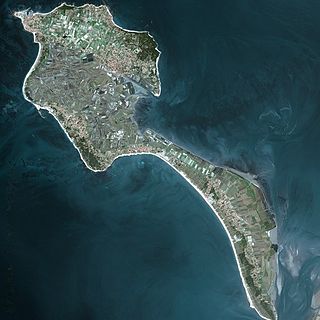
Noirmoutier is a tidal island off the Atlantic coast of France in the Vendée department (85).
The Culture of Saint Lucia blends the influences of African, French, and English heritage. The official language of the island is English but Kreole, a form of French patois, remains an influential secondary language. The people are predominantly Catholic but the religious climate is tolerant.
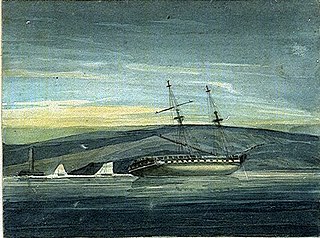
The third HMS Shannon was a 36-gun Perseverance-class frigate of the British Royal Navy built at Frindsbury on the River Medway on the Thames Estuary. She was completed on 3 September 1803 during the Napoleonic Wars. Her name was changed from Pallas to Shannon shortly before construction, traditionally an omen of bad luck for a ship. In her case, she was wrecked within three months of her being launched.
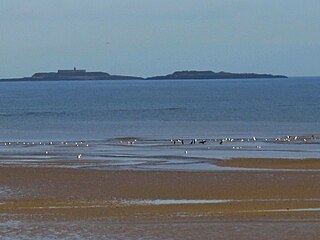
Îles Saint-Marcouf comprise two small uninhabited islands off the coast of Normandy, France. They lie in the Baie de la Seine region of the English Channel and are 6.5 km (4.0 mi) east of the coast of the Cotentin peninsula at Ravenoville and 13 km (8 mi) from the island of Tatihou and the harbour at Saint-Vaast-la-Hougue. In addition to the fortifications described below, on the larger island there is a lighthouse that dates to 1948.

The action at La Hogue occurred during the pursuit by the English of the French fleet after the Battle of Barfleur on 19 May Old Style, 1692, during the Nine Years' War. The pursuing English fleet, under the command of Admiral of the Fleet Edward Russell, 1st Earl of Orford, destroyed a number of French ships that had been beached near the port of Saint-Vaast-la-Hougue.

The Fortifications of Vauban is a UNESCO World Heritage Site made up of 12 groups of fortified buildings and sites along the borders of France. They were designed by renowned military architect Sébastien Le Prestre de Vauban (1633–1707) during the reign of King Louis XIV. These sites include a variety of fortifications, ranging from citadels, to mountain batteries and sea fortifications, to bastion walls and towers. In addition, the site includes cities built from scratch by Vauban and communication towers. These sites were chosen because they exemplify Vauban's work, bearing witness to the influence of his designs on military and civilian engineering on a global scale from the 17th century to the 20th century.

The Battle of the Îles Saint-Marcouf was an engagement fought off the Îles Saint-Marcouf near the Cotentin peninsula on the Normandy coast of France in May 1798 during the French Revolutionary Wars. Dislodging a British garrison on the islands was the main objective for French forces. The garrison allowed the islands to serve as a resupply base for Royal Navy ships patrolling northern French waters. Apart from expelling the British, the French sought to test new equipment and tactics, which had allegedly been developed with an intention of invading Britain.

The Western Rocks are a group of uninhabited skerries and rocks in the south–western part of the Isles of Scilly, United Kingdom, and are renowned for the numerous shipwrecks in the area and the nearby Bishop Rock lighthouse. In 1971, the rocks and islands were designated a Site of Special Scientific Interest for their breeding sea birds. Landing on the islands is both difficult and discouraged and there are few published records of visits by naturalists.

The Casuarina Islets, also known as The Brothers, is a pair of islands located in the Great Australian Bight immediately off the south-west coast of Kangaroo Island in South Australia approximately 96 kilometres south-west of Kingscote. The pair is currently part of the Flinders Chase National Park.

The action of 15 November 1810 was a minor naval engagement fought during the British Royal Navy blockade of the French Channel ports in the Napoleonic Wars. British dominance at sea, enforced by a strategy of close blockade, made it difficult for the French Navy to operate even in their own territorial waters. In the autumn of 1810, a British squadron assigned to patrol the Baie de la Seine was effectively isolating two French squadrons in the ports of Le Havre and Cherbourg-en-Cotentin. On 12 November, the squadron in Le Havre, consisting of frigates Elisa and Amazone attempted to reach Cherbourg at night in order to united the squadrons. This squadron was spotted in the early hours of 13 November by the patrolling British frigates HMS Diana and HMS Niobe, which gave chase.













